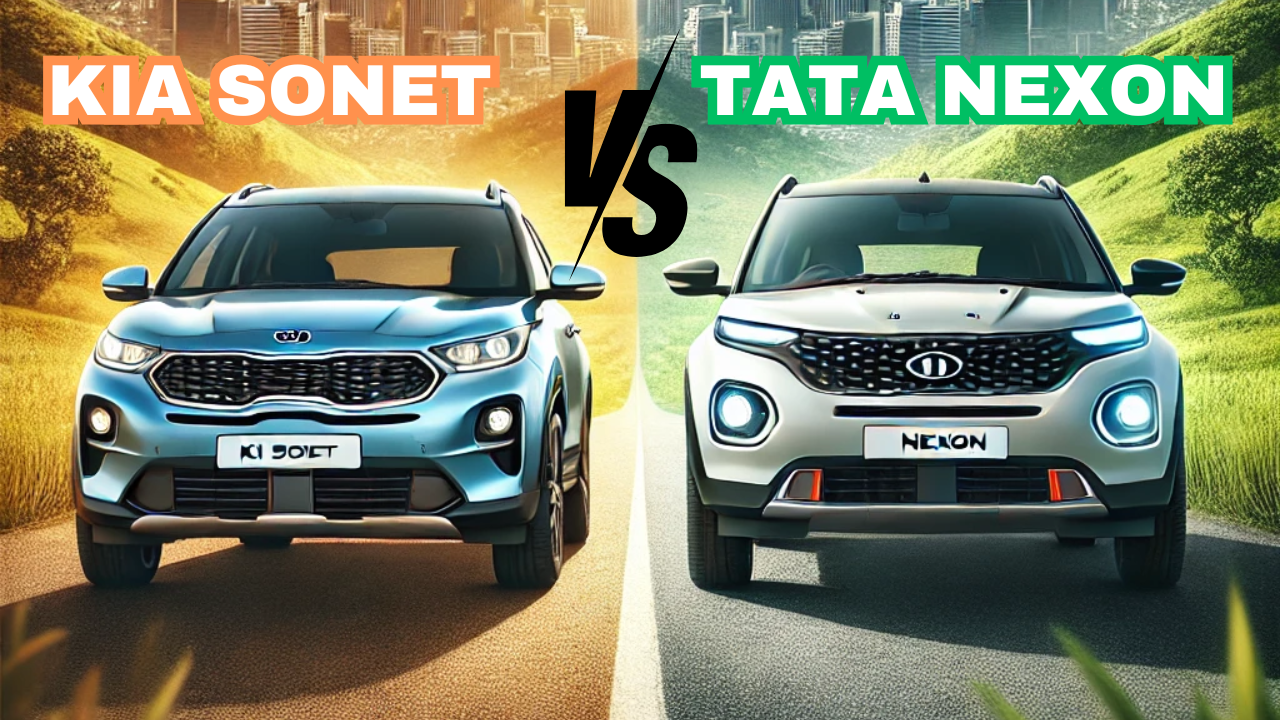There is intense competition in India’s quickly expanding compact SUV market. Enter the Kia Sonet, a stylish, feature-packed contender that has arrived with a mission: to challenge the dominance of the Tata Nexon, India’s long-standing champion in this category. This battle isn’t just about market share; it’s about redefining what Indian consumers can expect from affordable yet premium SUVs.
This comprehensive, easy-to-read comparison answers a crucial query: can the Kia Sonet truly replace the Tata Nexon?
Design and Style: A Visual Statement
When it comes to design, the Kia Sonet is a head-turner. It features:
- Tiger-Nose Grille: Kia’s signature design element gives the Sonet a bold, aggressive stance.
- LED Headlamps with DRLs: Modern and sharp, they enhance visibility while adding to its sporty aesthetic.
- Muscular Stance: Sleek lines and strong proportions make it instantly appealing.
On the other hand, the refreshed Tata Nexon isn’t backing down. With:
- Wider Front Grille: A commanding presence that enhances the Nexon’s road appeal.
- Sharper Headlights: LED DRLs that amplify its stylish appearance.
- Robust Design: The Nexon’s bold stance speaks volumes about its rugged build quality.
Verdict:
The Sonet is the best option if you like a sleeker, global style. For those who love a robust, muscular look with a hint of familiarity, the Nexon is your pick.
Interior Comfort and Features
Both SUVs excel in providing a premium cabin experience. Let’s take a closer look:
Kia Sonet’s Interior Highlights:
- 10.25-inch Touchscreen: One of the largest in the segment with Apple CarPlay and Android Auto.
- Ventilated Front Seats: A standout feature for Indian summers.
- Bose Sound System: High-quality audio for music enthusiasts.
- Premium Materials: Soft-touch surfaces and a modern dashboard layout.
Tata Nexon’s Interior Highlights:
- Floating Infotainment Display: An advanced interface with crisp visuals.
- Digital Instrument Cluster: gives a futuristic vibe.
- Sunroof: Adds a luxurious feel for those who love open skies.
- Comfortable Seating: spacious interiors with excellent cushioning.
Verdict:
The Nexon’s spaciousness and sunroof give it a distinct appeal, but the Sonet’s ventilated seats and high-end technology make it stand out.
Performance and Mileage
Both SUVs bring an impressive range of engines to the table:
Kia Sonet Engine Options:
- 1.2L Petrol: A balanced engine for city driving.
- 1.0L Turbo-Petrol: offers thrilling performance with higher torque.
- 1.5L Diesel: Best-in-class fuel efficiency at 24.1 kmpl.
Tata Nexon Engine Options:
- 1.2L Turbo-Petrol: Delivers strong performance and good mileage.
- 1.5L Diesel: Known for its durability and mileage of 24.08 kmpl.
On-Road Experience:
- Sonet: Agile and nimble, ideal for urban driving.
- Nexon: sturdy and smooth, perfect for handling rough roads and potholes.
Verdict:
With three engine options, the Kia Sonet is versatile, but the Nexon is superior in terms of stability and tough performance.
Safety Features: Prioritizing Protection
Safety is a significant deciding factor for Indian buyers, and both cars have a lot to offer:
Kia Sonet’s Safety Package:
- 6 Airbags
- ABS with EBD
- Hill Assist Control
- Electronic Stability Control
Tata Nexon’s Safety Package:
- 5-Star Global NCAP Safety Rating
- Dual Airbags (standard)
- ESP and Roll-Over Mitigation
- Advanced Rear Parking Assistance
Verdict:
While both SUVs are packed with safety features, the Nexon’s 5-star rating gives it an undeniable edge.
Pricing and Value for Money
Both the Sonet and Nexon are competitively priced, with base models starting at approximately ₹7.99 lakh (ex-showroom). As you move up the variants, the differences in features and pricing become more evident.
- Kia Sonet: Offers more premium features in higher trims but at a slightly higher cost.
- Tata Nexon: Balances features and pricing, offering value-for-money variants across the lineup.
Verdict:
For feature enthusiasts, the Sonet justifies its price tag. For those seeking robust value, the Nexon hits the sweet spot.
Comparison Table
| Feature | Kia Sonet | Tata Nexon |
|---|---|---|
| Starting Price | ₹7.99 lakh | ₹7.99 lakh |
| Engine Options | 1.2L Petrol, 1.0L Turbo, 1.5L Diesel | 1.2L Turbo-Petrol, 1.5L Diesel |
| Fuel Efficiency | 24.1 kmpl (Diesel) | 24.08 kmpl (Diesel) |
| Infotainment Screen | 10.25-inch | 7-inch (floating) |
| Key Features | Ventilated Seats, Bose Sound | Sunroof, Spacious Cabin |
| Safety Rating | 6 Airbags, ESC, ABS with EBD | 5-Star Global NCAP |
FAQs about Kia Sonet and Tata Nexon
1. Which SUV offers better fuel efficiency?
The Kia Sonet leads marginally with 24.1 kmpl for its diesel variant, while the Nexon delivers 24.08 kmpl. The difference is negligible.
2. Which car is safer for Indian roads?
The Tata Nexon, with its 5-star Global NCAP safety rating, is the safer option. However, the Kia Sonet’s safety features are also commendable.
3. Are ventilated seats available in Tata Nexon?
No, ventilated seats are exclusive to the Kia Sonet in this comparison.
4. Which SUV is better for city driving?
The Kia Sonet, with its compact design and agility, is better suited for urban environments.
5. What’s the key highlight of Tata Nexon?
The Nexon’s standout feature is its robust build quality and 5-star safety rating.
Conclusion: The Compact SUV War
Choosing between the Kia Sonet and Tata Nexon depends on your priorities. If you value premium features, international design, and versatility, the Sonet is an excellent choice. If safety, ruggedness, and familiarity top your list, the Nexon remains a formidable option.
These SUVs have completely changed the market for small SUVs, giving Indian customers unprecedented access to reasonably priced luxury. Whether you pick the modern flair of the Sonet or the reliable charm of the Nexon, rest assured, you’re getting a top-notch vehicle.
Table of Contents
Also Read : 2024 Maruti Dzire vs Maruti Swift: A Comprehensive Comparison
Maruti Dzire Facelift 2024: Redefining Compact Sedans in India
